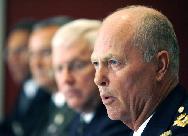Mr. Elliott, just one month into his new job as head of the
RCMP, said the collaboration allows police to track and arrest
gang members who operate across city, provincial and territorial
boundaries.
He said several large, multi-jurisdictional
crackdowns on motorcycle gangs over the past year have led to
the seizure of quantities of “illicit products” and the arrest
of key criminals.
Organized crime groups vary widely in organization and size —
from highly structured groups such as the Mafia and Hells Angels
— to much more loosely formed street gangs.
While the criminal capabilities of these groups vary, a great
many of them are involved in selling everything from street
drugs and guns to stolen cars and human smuggling.
The annual report says about 80 per cent of organized crime
groups are involved in the illegal drug trade, but no single
group dominates the market.
Most groups continue to use legitimate businesses to hide
their activities and launder their cash.
The report also confirmed that nearly all organized crime
groups “network or collaborate” with each other on an informal
basis, like combining funds to finance a large drug shipment or
production operation.
Mr. Elliott, who is the RCMP's first commissioner without
either police or military experience, said there's evidence of
more sophisticated groups coming together with less
sophisticated ones for specific projects.
Calgary Police chief Jack Beaton said market-sharing
agreements between different groups are made especially in the
lucrative drug trade.
“What we don't like to see ... is the violence that erupts
when they can't come to a letter of understanding or memorandum
of agreement,” he said. “And that's what we see often in our
community.”
Organized crime groups also continue to make greater use of
technology, particularly cellphones and other types of wireless
communication that helps “insulate” them from detection by
police.
Public Safety Minister Stockwell Day said the increase of
crime on the Internet has also allowed criminal organizations to
share information more easily.
“These groups will do that up until an issue becomes
territorial — they'll want to enhance or increase their profits
or territory,” Mr. Day said Friday from Vancouver.
“If they feel one group is moving in on the other, that's
when we see some of the gangland-related crime and shootings
that have taken place.”
Mr. Day said the increase in the number of organized crime
groups is not a surprise. Part of the increase, he said, comes
from the splintering of groups as they fight each other and move
into new areas.
The report also says that while the illegal drug trade helps
fuel the market for illegal firearms, most criminal
organizations are not actively involved in the large-scale
retail and distribution of banned guns.
